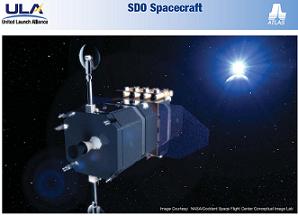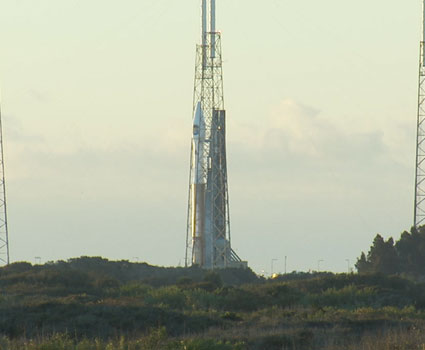NASA is launching its Solar Dynamics Observatory aka SDO today. The launching time has been delayed for a lot of time. The launch time is pushed back to 11:26 a.m. It’s the latest news that we got.

The Solar Dynamics Observatory is the first mission to be launched for NASA’s Living With a Star (LWS) Program, a program designed to understand the causes of solar variability and its impacts on Earth. SDO is designed to help us understand the Sun’s influence on Earth and Near-Earth space by studying the solar atmosphere on small scales of space and time and in many wavelengths simultaneously.
The Atlas V rocket is scheduled to launch NASA’s Solar Dynamics Observatory (SDO) from Cape Canaveral Air Force Station at 11:26 EST (14:26 GMT), at the end of the 60-minute launch window, due to high ground level winds.

SDO’s goal is to understand, driving towards a predictive capability, the solar variations that influence life on Earth and humanity’s technological systems by determining
- how the Sun’s magnetic field is generated and structured
- how this stored magnetic energy is converted and released into the heliosphere and geospace in the form of solar wind, energetic particles, and variations in the solar irradiance.
The launch of SDO will mark the 20th flight of the veteran Atlas V rocket – a rocket which has a tremendous success record: only one partial failure which was actually deemed a success by its payload customer, the National Reconnaissance Office.
For this launch, the Atlas V will fly in its 401 configuration: no solid rocket motors, a single-engine Centaur upper stage, and a four-meter diameter payload fairing. This configuration is the most frequently used Atlas V configuration, having been used on half of all Atlas V launches.
The launch will be conducted from Space Launch Complex 41 (SLC-41) at the Cape Canaveral Air Force Station (CCAFS) – just a few miles from nearby Launch Complex 39A which Endeavour launched from just two days ago.
SLC-41 was originally built in the 1960s for the venerable Titan rocket fleet. The first launch from the complex was made by a Titan IIIC in December 1965. The launch pad was later used for Titan IIIE, or Titan-Centaur, launches during the 1970s. This version of the Titan rocket was responsible for the launches of the Helios, Viking, and Voyager probes, among others.
SDO will study how solar activity is created and how Space Weather comes from that activity. Measurements of the interior of the Sun, the Sun’s magnetic field, the hot plasma of the solar corona, and the irradiance that creates the ionospheres of the planets are our primary data products.
SDO will fly three scientific experiments:
- Atmospheric Imaging Assembly (AIA)
- EUV Variability Experiment (EVE)
- Helioseismic and Magnetic Imager (HMI)
Each of these experiments perform several measurements that characterize how and why the Sun varies. These three instruments will observe the Sun simultaneously, performing the entire range of measurements necessary to understand the variations on the Sun.
Specs
SDO is a sun-pointing semi-autonomous spacecraft that will allow nearly continuous observations of the Sun with a continuous science data downlink rate of 130 Megabits per second (Mbps). The spacecraft is 4.5 meters high and over 2 meters on each side, weighing a total of 3100 kg (fuel included). SDO’s inclined geosynchronous orbit was chosen to allow continuous observations of the Sun and enable its exceptionally high data rate through the use of a single dedicated ground station.
The science of the Solar Dynamics Observatory will be performed on a spacecraft that allows both nearly continuous observations of the Sun and a science data downlink rate over of 100 Megabits per second (Mbps). These two requirements determined the orbit and spacecraft design as well as the definition of the SDO Mission.
Satellite
- 3-Axis stabilized & robust spacecraft.
- Launch mass of 3100 kg (weight of 6800 lbs); 270 kg payload, 1400 kg fuel.
- Spacecraft is 2.2 x 2.2 x 4.5 m, solar panels are 6.5 m across when extended.
- Solar panels cover an area of 6.6 m², producing 1450 W of power. The homeplate shape prevents the solar panel from blocking the high-gain antennas.
- Science data is sent to the ground at a rate of ~130 Mbps on a continuous, high rate data stream at a Ka-Band frequency of ~26 GHz.
Launch
- SDO will be ready in February 10, 2010, 10:26 am EST [Though it has been pushed back to 11:26 a.m.] for a launch on an Atlas V from SLC 41 at Cape Canaveral.
- The observatory will be delivered into a geosynchronous transfer orbit (GTO) by the Atlas V. SDO’s propulsion system will then perform a circularization maneuver to boost the spacecraft into geosynchronous orbit (GEO).
- SDO’s main engine is a bi-propellant system using monomethyl hydrazine (MMH) fuel and nitrogen tetroxide (NTO) oxidizer. Thrusters using the same fuel and oxidizer mix will keep SDO in the correct orbit during the mission.
Orbit
- The rapid cadence and continuous coverage required for SDO observations led to placing the satellite into an inclined geosynchronous orbit. This allows for a nearly-continuous, high-data-rate, contact with a single, dedicated, ground station.
- Nearly continuous observations of the Sun can be obtained from other orbits, such as low Earth orbit (LEO). If SDO were placed into an LEO it would be necessary to store large volumes of scientific data onboard until a downlink opportunity. The large data rate of SDO, along with the difficulties in managing a large on-board storage system, resulted in a requirement of continuous contact.
- The disadvantges of this orbit include higher launch and orbit acquisition costs (relative to LEO) and eclipse (Earth shadow) seasons twice annually, During these 2-3 week eclipse periods, SDO will experience a daily interruption of solar observations. There will also be three lunar shadow events each year from this orbit.
- This orbit is located on the outer reaches of the Earth’s radiation belt where the radiation dose can be quite high. Additional shielding was added to the instruments and electronics to reduce the problems caused by exposure to radiation. Because this a a Space Weather effect, SDO is affected by the very processes it is designed to study!




Pingback: uberVU - social comments
Pingback: NASA's Solar Dynamics Observatory lançons aujourd'hui: mis à jour